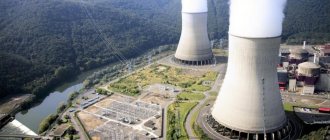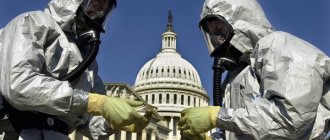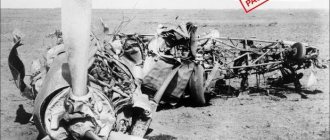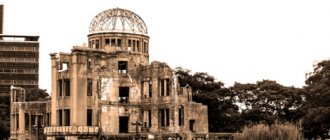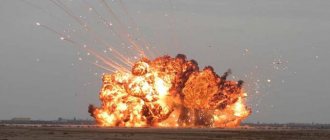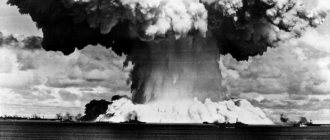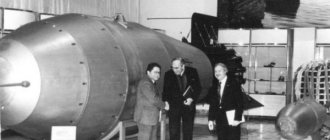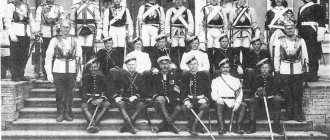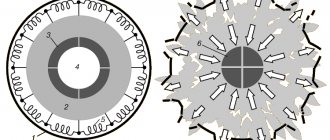Types of nuclear explosions and their differences in external characteristics.
Nuclear explosions can be carried out in the air at different heights, near the surface of the earth (water) and underground (water). In accordance with this, nuclear explosions are divided into airborne, high-altitude, ground (surface) and underground (underwater).
Aerial nuclear explosion.
Aerial nuclear explosions include explosions in the air at such a height that the luminous area of the explosion does not touch the surface of the earth (water)
One sign of an airburst is that the dust plume does not connect with the explosion cloud (high airburst). The air burst can be high or low.
The point on the surface of the earth (water) above which the explosion occurred is called the epicenter of the explosion.
An aerial nuclear explosion begins with a dazzling, short-term flash, the light from which can be observed at a distance of several tens and hundreds of kilometers.
Following the flash, a spherical luminous area appears at the site of the explosion, which quickly increases in size and rises. The temperature of the luminous region reaches tens of millions of degrees. The luminous area serves as a powerful source of light radiation. As the fireball grows in size, it quickly rises and cools, turning into a rising swirling cloud. When a fireball rises, and then a swirling cloud, a powerful upward flow of air is created, which sucks dust raised by the explosion from the ground, which is held in the air for several tens of minutes.
With a low air burst
a column of dust raised by an explosion may merge with the explosion cloud; the result is a mushroom-shaped cloud.
If an air explosion occurs at a high altitude, the dust column may not connect with the cloud. The cloud of a nuclear explosion, moving with the wind, loses its characteristic shape and dissipates.
A nuclear explosion is accompanied by a sharp sound, reminiscent of a strong clap of thunder. Aerial explosions can be used by the enemy to defeat troops on the battlefield, destroy city and industrial buildings, and destroy aircraft and airfield structures.
The damaging factors of an airborne nuclear explosion are: shock wave, light radiation, penetrating radiation and electromagnetic pulse.
High altitude nuclear explosion.
A high-altitude nuclear explosion is carried out at an altitude of 10 km or more from the surface of the earth. During high-altitude explosions at an altitude of several tens of kilometers, a spherical luminous area is formed at the explosion site; its dimensions are larger than during an explosion of the same power in the ground layer of the atmosphere. After cooling, the glowing area turns into a swirling ring cloud. A dust column and dust cloud are not formed during a high-altitude explosion.
In nuclear explosions at altitudes up to 25-30 km, the damaging factors of this explosion are a shock wave, light radiation, penetrating radiation and an electromagnetic pulse.
As the height of the explosion increases due to atmospheric rarefaction, the shock wave weakens significantly, and the role of light radiation and penetrating radiation increases. Explosions occurring in the ionospheric region create areas or regions of increased ionization in the atmosphere, which can affect the propagation of radio waves (ultra-short wave range) and disrupt the operation of radio equipment.
There is practically no radioactive contamination of the earth's surface during high-altitude nuclear explosions.
High-altitude explosions can be used to destroy air and space attack and reconnaissance weapons: aircraft, cruise missiles, satellites, and ballistic missile warheads.
Ground nuclear explosion.
A ground nuclear explosion is an explosion on the surface of the earth or in the air at a low altitude, in which the luminous area touches the ground.
In a ground explosion, the luminous area has the shape of a hemisphere, lying with its base on the surface of the earth. If a ground explosion is carried out on the surface of the earth (contact explosion) or in close proximity to it, a large crater is formed in the ground, surrounded by a bank of earth.
The size and shape of the crater depends on the power of the explosion; The diameter of the funnel can reach several hundred meters.
With a ground explosion, a powerful dust cloud and dust column are formed than with an air explosion, and from the moment of its formation, the dust column is connected to the explosion cloud, as a result of which a huge amount of soil is drawn into the cloud, which gives it a dark color. Mixing with radioactive products, the soil contributes to their intensive precipitation from the cloud. In a ground explosion, radioactive contamination of the area in the area of the explosion and in the wake of the cloud is much stronger than in an air explosion. Ground explosions are intended to destroy objects consisting of highly durable structures and defeat troops located in strong shelters, if strong radioactive contamination of the area and objects in the area of the explosion or in the cloud trail is acceptable or desirable.
These explosions are also used to destroy openly positioned troops if it is necessary to create severe radioactive contamination of the area. In a ground-based nuclear explosion, the damaging factors are a shock wave, light radiation, penetrating radiation, radioactive contamination of the area and an electromagnetic pulse.
Underground nuclear explosion.
An underground nuclear explosion is an explosion produced at some depth in the earth.
With such an explosion, the luminous region may not be observed; During the explosion, enormous pressure is created on the ground, the resulting shock wave causes vibrations in the soil, reminiscent of an earthquake. A large crater is formed at the site of the explosion, the dimensions of which depend on the power of the charge, the depth of the explosion and the type of soil; A huge amount of soil mixed with radioactive substances is thrown out of the funnel, forming a column. The height of the pillar can reach many hundreds of meters.
During an underground explosion, a characteristic mushroom cloud, as a rule, does not form. The resulting column is much darker in color than the cloud of a ground explosion. Having reached its maximum height, the pillar begins to collapse. Radioactive dust, settling on the ground, heavily contaminates the area in the area of the explosion and along the path of the cloud.
Underground explosions can be carried out to destroy particularly important underground structures and create rubble in the mountains in conditions where severe radioactive contamination of the area and objects is acceptable. In an underground nuclear explosion, the damaging factors are seismic blast waves and radioactive contamination of the area.
Surface nuclear explosion.
This explosion has an external resemblance to a ground-based nuclear explosion and is accompanied by the same damaging factors as a ground-based explosion. The difference is that the mushroom cloud of a surface explosion consists of a dense radioactive fog or water mist.
Characteristic of this type of explosion is the formation of surface waves. The effect of light radiation is significantly weakened due to shielding by a large mass of water vapor. The failure of objects is determined mainly by the action of an air shock wave.
Radioactive contamination of water areas, terrain and objects occurs due to the fall of radioactive particles from the explosion cloud. Surface nuclear explosions can be carried out to destroy large surface ships and strong structures of naval bases and ports, when severe radioactive contamination of water and coastal areas is acceptable or desirable.
Underwater nuclear explosion.
An underwater nuclear explosion is an explosion carried out in water at one depth or another.
With such an explosion, the flash and glowing area are usually not visible.
During an underwater explosion at a shallow depth, a hollow column of water rises above the water surface, reaching a height of more than a kilometer. A cloud consisting of splashes and water vapor forms at the top of the column. This cloud can reach several kilometers in diameter.
A few seconds after the explosion, the water column begins to collapse and a cloud called a basis wave forms at its base. The base wave consists of radioactive fog; it quickly spreads in all directions from the epicenter of the explosion, and at the same time rises up and is carried by the wind.
After a few minutes, the base wave mixes with the sultan cloud (a sultan is a swirling cloud enveloping the upper part of the water column) and turns into a stratocumulus cloud, from which radioactive rain falls. A shock wave is formed in the water, and on its surface - surface waves propagating in all directions. The height of the waves can reach tens of meters.
Underwater nuclear explosions are designed to destroy ships and destroy underwater structures. In addition, they can be carried out for severe radioactive contamination of ships and the coastline.
Explosion of the first atomic bomb
First, everyone saw a bright luminous point, which was visible at a distance of 290 km. from the testing site. At the same time, the sound of the explosion was heard within a radius of 160 km. A huge crater formed at the site where the nuclear explosive device was installed. The crater from the nuclear explosion reached a depth of more than 20 meters, having an outer diameter of 70 m. In the territory of the test site, within a radius of 300-400 meters from the epicenter, the surface of the earth was a lifeless lunar surface.
It is interesting to cite the recorded impressions of participants in the first atomic bomb test. “The surrounding air became denser, and its temperature instantly rose. Literally a minute later, a huge shock wave swept across the area. A huge fireball forms at the point where the charge is located, after which a mushroom-shaped cloud of nuclear explosion begins to form in its place. A column of smoke and dust, topped with a massive nuclear mushroom head, rose to a height of 12 km. Everyone present in the shelter was amazed by the scale of the explosion. No one could imagine the power and strength we faced,” Leslie Groves, the head of the Manhattan Project, subsequently wrote.
No one before or since had such enormous power at their disposal. This is despite the fact that at that time scientists and the military did not yet have an idea of all the damaging factors of the new weapon. Only the visible main damaging factors of a nuclear explosion were taken into account, such as:
- shock wave of a nuclear explosion;
- light and thermal radiation from a nuclear explosion.
At that time, they did not yet have a clear idea that penetrating radiation and subsequent radioactive contamination during a nuclear explosion are deadly for all living things. It turned out that these two factors after a nuclear explosion will subsequently become the most dangerous for humans. The zone of complete destruction and devastation is quite small in area compared to the zone of contamination of the area with radiation decay products. The contaminated area may cover hundreds of kilometers. To the exposure received in the first minutes after the explosion, and to the level of radiation subsequently added to the contamination of large areas by radiation fallout. The scale of the disaster is becoming apocalyptic.
Only later, much later, when atomic bombs were used for military purposes, it became clear how powerful the new weapon was and how severe the consequences of using a nuclear bomb would be for people.
IMPORTANCE OF HALF ATTENUATION LAYER FOR SOME MATERIALS
| Material | Density, g/cm3 | Half attenuation layer, cm | |
| by neutrons | by gamma radiation | ||
| Water | 1 | 3 | 20 |
| Polyethylene | 0,9 | 3 | 22 |
| Steel | 7,8 | 11 | 3 |
| Lead | 11,3 | 12 | 2 |
| Priming | 1,6 | 9 | 13 |
| Concrete | 2,3 | 8 | 10 |
| Tree | 0,7 | 10 | 30 |
The attenuation coefficient of penetrating radiation during a ground explosion with a power of 10 thousand tons for a closed armored personnel carrier is 1.1. For a tank - 6, for a full-profile trench - 5. Under-parapet niches and blocked cracks weaken radiation by 25-50 times; The dugout coating attenuates radiation by 200-400 times, and the shelter coating by 2000-3000 times. A 1 m thick wall of a reinforced concrete structure attenuates radiation by approximately 1000 times; tank armor weakens radiation by 5-8 times.
Radioactive contamination of the area.
Radioactive contamination of the area, atmosphere and various objects during nuclear explosions is caused by fission fragments, induced activity and the unreacted part of the charge.
The main source of radioactive contamination during nuclear explosions are radioactive products of nuclear reactions - fission fragments of uranium or plutonium nuclei. The radioactive products of a nuclear explosion that settle on the surface of the earth emit gamma rays, beta and alpha particles (radioactive radiation).
Radioactive particles fall from the cloud and contaminate the area, creating a radioactive trail at distances of tens and hundreds of kilometers from the center of the explosion. According to the degree of danger, the contaminated area following the cloud of a nuclear explosion is divided into four zones.
Zone A
– moderate infection.
The radiation dose until the complete decay of radioactive substances at the outer boundary of the zone is 40 rad, at the inner boundary - 400 rad. Zone B
– severe infection – 400-1200 rad.
Zone B
– dangerous infection – 1200-4000 rad.
Zone D
- extremely dangerous infection - 4000-7000 rad.
In contaminated areas, people are exposed to radioactive radiation, as a result of which they may develop radiation sickness. No less dangerous is the ingress of radioactive substances into the body, as well as onto the skin. Thus, if even small amounts of radioactive substances come into contact with the skin, especially the mucous membranes of the mouth, nose and eyes, radioactive damage can occur.
Weapons and equipment contaminated with radioactive substances pose a certain danger to personnel if handled without protective equipment. In order to prevent damage to personnel from the radioactivity of contaminated equipment, permissible levels of contamination with the products of nuclear explosions have been established that do not lead to radiation injury. If contamination is higher than permissible standards, then it is necessary to remove radioactive dust from surfaces, i.e., decontaminate them.
Radioactive contamination, unlike other damaging factors, lasts for a long time (hours, days, years) and over large areas. It has no external signs and is detected only with the help of special dosimetric instruments.
Electromagnetic pulse.
The electromagnetic fields accompanying nuclear explosions are called electromagnetic pulses (EMPs).
In ground and low air explosions, the damaging effects of EMP are observed at a distance of several kilometers from the center of the explosion. During a high-altitude nuclear explosion, EMR fields can arise in the explosion zone and at altitudes of 20-40 km from the earth's surface.
The damaging effect of EMR manifests itself, first of all, in relation to radio-electronic and electrical equipment located in weapons and military equipment and other objects. Under the influence of EMR, electric currents and voltages are induced in the specified equipment, which can cause insulation breakdown, damage to transformers, damage to semiconductor devices, burnout of fuse links and other elements of radio engineering devices.
Seismic blast waves in the ground.
During air and ground nuclear explosions, seismic explosion waves are formed in the ground, which are mechanical vibrations of the ground. These waves propagate over long distances from the epicenter of the explosion, cause deformation of the soil and are a significant damaging factor for underground, mine and pit structures.
The source of seismic blast waves in an air explosion is an air shock wave acting on the surface of the earth. In a ground explosion, seismic blast waves are formed both as a result of the action of an air shock wave and as a result of the transfer of energy to the ground directly at the center of the explosion.
Seismic blast waves form dynamic loads on structures, building elements, etc. Structures and their structures undergo oscillatory movements. The stresses arising in them, when reaching certain values, lead to destruction of structural elements. Vibrations transmitted from building structures to weapons, military equipment and internal equipment located in structures can lead to their damage. Personnel may also be affected as a result of the effects of overloads and acoustic waves caused by the oscillatory movement of structure elements.
The Birth of Nuclear Weapons
Back in 1939, the Frenchman Joliot-Curie realized that exposure to uranium nuclei under certain conditions could lead to an explosive reaction of enormous power. As a result of a nuclear chain reaction, spontaneous exponential fission of uranium nuclei begins and a huge amount of energy is released. In an instant, the radioactive substance exploded, and the resulting explosion had a huge damaging effect. As a result of the experiments, it became clear that uranium (U235) can be converted from a chemical element into a powerful explosive.
For peaceful purposes, when a nuclear reactor is operating, the process of nuclear fission of radioactive components is calm and controlled. In a nuclear explosion, the main difference is that a colossal amount of energy is released instantly and this continues until the supply of radioactive explosives runs out. The first time a person learned about the combat capabilities of the new explosive was on July 16, 1945. While the final meeting of the Heads of State of the victors of the war with Germany was taking place in Potsdam, the first test of an atomic warhead took place at the Alamogordo test site in New Mexico. The parameters of the first nuclear explosion were quite modest. The power of the atomic charge in TNT equivalent was equal to the mass of trinitrotoluene of 21 kilotons, but the force of the explosion and its impact on surrounding objects made an indelible impression on everyone who observed the tests.
The effect of damaging factors at the time of an air explosion[edit | edit code]
Injury to a person in an air explosion[edit | edit code]
The degree and type of injury to a person at the time of the explosion depends on many factors: weather, surrounding landscape and buildings, clothing and protective equipment, and others. Here, for the sake of simplicity, only the impact of the damaging factors of the explosion itself in ideal conditions and in a clear, cloudless atmosphere on a person who does not have special protective equipment is considered (unless specifically stated).
The main damaging factors at the moment of explosion are light radiation, shock wave, and penetrating radiation. The extent of their impact depends on:
- bomb power
- distance of a person from the epicenter of the explosion
Thus, when an ultra-large bomb explodes at a distance where it is impossible to receive any radiation and mechanical damage (over 7500 m from the epicenter for a 1 Mt bomb), severe thermal burns are possible: 4th degree - up to 11000 m from the epicenter; 3rd degree - up to 13000 m.
On the contrary, when a low-power bomb explodes at a distance where serious thermal and mechanical damage cannot be sustained (more than 500 m from the epicenter for a 1 kt bomb), a person receives a charge of penetrating radiation sufficient to develop the most severe form of radiation sickness (at a distance of up to 750 m from the epicenter; milder forms of infection are possible at a distance of up to 1600 m). This form of damage is used and artificially enhanced in neutron munitions.
The table below summarizes data on the damage to a person at various distances when a bomb with a power of 20 kt explodes.[3][9][10][11] Also given is the percentage of fatal injuries depending on the distance to the epicenter during the bombings of Hiroshima and Nagasaki in 1945.[12]
| Distance from the epicenter of the explosion, m: | Description of the lesion | Effect of the damaging factor | Mortality in Hiroshima and Nagasaki, % of deaths (distance from epicenter) | ||
| Light radiation (degree of burns) | Shock wave (damage level) | Penetrating radiation (degree of radiation sickness) | |||
| up to 580 | The man turns into a charred and disfigured corpse. Rescue is probably only possible in shelters | fourth | fatal | extremely heavy | 92—93 (up to 609 m) |
| 580—870 | Severe burns; severe mechanical and radiation damage to internal organs, limb fractures. In most cases - death immediately or in the coming days from burns and mechanical injuries; death from radiation sickness within 1-2 months. | heavy | 86 (609–914 m) | ||
| 870—1120 | Same. The degree of mechanical injuries is slightly reduced | average | 69 (914–1219 m) | ||
| 1120—1270 | Severe burns and radiation damage with relatively mild mechanical injuries. The probability of death is very high. | light | |||
| 1270—1350 | Severe burns, complicated after 30-60 minutes by the first signs of radiation sickness; the height of radiation sickness in 8-20 days. Healing of burns begins only after 20-30 days. General treatment lasts at least 3-6 months | heavy | 49 (1219—1524) | ||
| 1350—1450 | Severe burns; primary symptoms of radiation sickness occur within 1-2 hours. The height of the disease is in 20-30 days. Treatment time is 2-3 months. | average | |||
| 1450—1550 | Severe burns that take at least 5 weeks to heal. Radiation sickness manifests itself after 3-6 weeks: weakness, nausea, fever. Treatment is outpatient | light | |||
| 1550—1600 | Severe superficial burns up to the death of skin and muscles. Even light clothing will protect you well from burns, but in a clear atmosphere it can ignite (white cotton fabric catches fire at a distance of up to 1800 m). Burns heal in 3-5 weeks. Radiation sickness manifests itself after 3-6 weeks and is treated on an outpatient basis. | third | 31.5 (1524-1829 m) | ||
| 1600—1900 | Severe skin burns. Bruises and dislocations. | ||||
| 1900—2000 | Formation of blisters on the skin; with a large burn area, death is possible; bruises and dislocations | second | 12.5 (1829–2133 m) | ||
| 2000—2800 | Blistering of the skin | 0.5–1.3 (2133–2743 m) | |||
| 2800—3800 | Redness or swelling of the skin - usually not dangerous | first | 0 (further 2743 m) | ||
Damage to buildings and structures during an air explosion[edit | edit code]
There are four degrees of destruction of buildings: weak, medium, strong and complete. Weak destruction - destruction mainly of window and door frames. Medium - destruction of non-load-bearing roofs and partitions, the appearance of cracks that do not threaten collapse. Severe - destruction of part of the walls and ceilings; It is possible to use only part of the basements after clearing. Complete - destruction of all elements; any use of the building is impossible. For most residential and industrial buildings, the failure zone is the zone of moderate destruction. The exception is a number of industrial buildings with a strong frame, in which moderate damage does not threaten the safety of people and allows the production process to continue. For them, the zone of failure is considered to be a zone of severe destruction.[13]
Radii of failure zones of buildings and structures during explosions with a power of 20 kilotons and 1 Megaton, m
[14]
| 20 kt | 1 Mt |
| 180 | 700 | underground utilities |
| 310 | 1100 | basement shelters |
| 540 | 1990 | reinforced concrete bridges |
| 950 | 3490 | metal bridges |
| 1110 | 4100 | buildings with reinforced concrete frame |
| 1220 | 4500 | steel frame buildings |
| 2120 | 7800 | brick low-rise buildings |
| 2540 | 9350 | brick multi-story buildings |
| 3470 | 12800 | wooden buildings |
Damage to military equipment during an air explosion[edit | edit code]
When assessing damage to military equipment, it is customary to distinguish between weak, medium, severe damage and complete destruction. Damage that can be repaired in the field by crews and crews is considered weak. As a rule, mild damage does not significantly reduce the combat effectiveness of ground-based combat equipment, but in most cases they make missile, aircraft and automobile equipment unsuitable for carrying out their missions. Therefore, for rocket, aircraft and automotive equipment, the radius of the failure zone is taken to be the radius of the weak damage zone; for other types of equipment - the radius of the zone of moderate damage, the elimination of which requires repairs in military or central repair shops.[15]
Radius of zones of failure of equipment and weapons during explosions with a power of 20 kilotons and 1 Megaton, m
[16]
| 20 kt | 1 Mt |
| 450 | 1640 | tanks |
| 770 | 2850 | BMP, armored personnel carrier, self-propelled guns |
| 1080 | 3990 | MLRS |
| 1230 | 4550 | ballistic missiles on launchers |
| 1450 | 5340 | fighters |
| 1950 | 7200 | cars |
| 3100 | 11400 | bombers |
| 4340 | 16000 | transport aircraft |
| 4340 | 16000 | helicopters |
Notes[edit | edit code]
- ↑ a b Nuclear weapons.
Manual for officers .
— 4th ed. - M.: Military Publishing House, 1987. - P. 14. about the book - ↑ a b “Distribution of energy released during nuclear explosions.” Nuclear Attack resource.
- ↑ a b c d Gorishny V. A., Chernetsov V. B., Volkov V. V. Wartime emergency situations
.
about the book - Nuclear explosions
= Nuclear explosions and their effects Transl
from English Kravtsova N.
F.
- M.: Foreign Literature Publishing House, 1958. - P. 68. about the book - Atomic weapons damage and medical care issues
.
- M.: Military Publishing House of the USSR Ministry of Defense, 1957. - P. 32. about the book - A Brief Guide to the Combat Properties of Nuclear Weapons
.
— 2nd ed. - M.: Military Publishing House of the USSR Ministry of Defense, 1969. - P. 30. about the book - Nuclear explosions
= Nuclear explosions and their effects Transl
from English Kravtsova N.
F.
- M.: Foreign Literature Publishing House, 1958. - P. 66-67. about the book - A Brief Guide to the Combat Properties of Nuclear Weapons
.
— 2nd ed. - M.: Military Publishing House of the USSR Ministry of Defense, 1969. - P. 40. about the book - A Brief Guide to the Combat Properties of Nuclear Weapons
.
— 2nd ed. - M.: Military Publishing House of the USSR Ministry of Defense, 1969. - P. 32-33, 38-39, 42. about the book - "Radiation sickness". Diseases.ru Medical encyclopedia.
- "Burns." Diseases.ru Medical encyclopedia.
- "Atomic Bombing of Hiroshima and Nagasaki, MED Report June 29, 1946." — Table B Mortality rates at various distances
- Nuclear weapon.
Manual for officers .
— 4th ed. - M.: Military Publishing House, 1987. - P. 137-138, 142. about the book - Nuclear weapon.
Manual for officers .
— 4th ed. - M.: Military Publishing House, 1987. - P. 141. about the book - Nuclear weapon.
Manual for officers .
— 4th ed. - M.: Military Publishing House, 1987. - P. 125. about the book - Nuclear weapon.
Manual for officers .
— 4th ed. - M.: Military Publishing House, 1987. - P. 132-134. about the book
